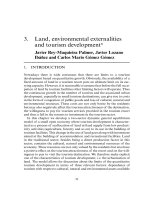THE ECONOMICS OF MONEY,BANKING, AND FINANCIAL MARKETS 483
Bạn đang xem bản rút gọn của tài liệu. Xem và tải ngay bản đầy đủ của tài liệu tại đây (28.22 KB, 1 trang )
CHAPTER 17
Tools of Monetary Policy
451
lost its ability to lower long-term interest rates by lowering short-term interest
rates.
For these reasons, many central banks around the world, including the Bank
of Japan, the U.S. Federal Reserve, and the Bank of England, have departed from
the traditional interest-rate targeting approach to monetary policy and are focusing on their balance sheet instead, using quantitative measures of monetary policy. The Bank of Canada is also considering such quantitative measures and has
recently identified three alternative instruments that it would consider using in an
environment with low short-term (nominal) interest rates: conditional statements
about the future path of the policy rate, quantitative easing, and credit easing.
Because the Bank of Canada has lost its ability to
influence long-term interest rates using conventional monetary policy tools,
recently the Bank started making conditional statements about the future path of
its policy rate in order to influence long-term interest rates. The objective of such
conditional commitments regarding the operating band for the overnight interest
rate is to align market expectations of future short-term interest rates with those
of the Bank to achieve desirable outcomes in interest rates throughout the term
structure.
For example, on April 21, 2009, the Bank of Canada lowered the policy rate by
0.25 of a percentage point to 0.25%, and it also committed to holding the policy
rate at 0.25% until the second quarter of 2010, conditional on the outlook for inflation. Such a conditional commitment by the Bank of Canada to keep the policy
rate at 25 basis points for a long period is expected to shape market expectations
of future short-term interest rates and lower long-term interest rates, since longterm rates are averages of current and expected future short-term interest rates
(plus risk premiums).
CONDITIONAL STATEMENTS
Quantitative easing refers to the purchase of financial
assets by the central bank through the creation of excess reserves (settlement balances in the Canadian case) for banks. This is the same as open market operations,
but extends to include private financial assets such as corporate bonds and commercial paper. By buying financial assets, the central bank affects the cost of borrowing by pushing up the price of the purchased assets and reducing their yields.
Moreover, by creating excess reserves for banks, the central bank encourages
banks to lend more to households and businesses, thereby increasing the level of
economic activity.
Quantitative easing is regarded as an unconventional form of monetary policy,
very different from interest-rate targeting that central banks and the financial markets around the world have used over the last twenty years. It targets the amount
of liquidity provided by the central bank instead of targeting the price of liquidity
(as interest-rate targeting does). The Bank of Japan used it during the early 2000s,
as did the Federal Reserve and the Bank of England during the recent global financial crisis. Quantitative easing, however, is a high-risk monetary policy tool as it
runs the risk of going too far, pumping too much money into the economy and
possibly creating inflation and even hyperinflation.
QUANTITATIVE EASING
Credit easing refers to the purchase of private sector assets by
the central bank in critical markets that are considered important for the effective
functioning of the economy. The objective of credit easing is to reduce risky
spreads and improve liquidity and trading in these markets, thereby stimulating
CREDIT EASING









